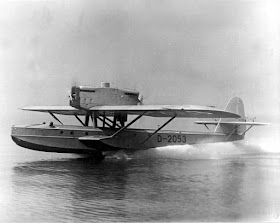The Smithsonian Air and Space Museum blog has a great article about Wolfgang von Gronau's around the world journeys using the Dornier Do-J Wal. It includes some gorgeous high resolution pictures of the D-2053, a specially modified Wal, taken during his 1932 circumnavigation.
The only significant difference between this aircraft and the ones in Lovecraft's tale would be the upgrades installed by Frank Pabodie. Conjecturally, that would include an enclosed cockpit, the use of aluminum to replace some of the plane's steel construction, and slightly lengthened wings. That's the only way to get the plane to match the levels of performance described in the story, at least from a Watsonian perspective.
This is one of the very few overhead shots of the Wal I've ever seen. As the scoring on the tail rudder demonstrates, "clean burning" was a pretty relative concept for early mid-century aircraft engines.
Gronau's earlier excursions used the D-1422, the exact same plane flown by Roald Amundsen (wearing the N-25 badge) during his 1925 arctic expedition. That specific plane is almost certainly the one that inspired the aircraft flown during the Miskatonic Antarctic Expedition in "At the Mountains of Madness". Amundsen's expedition had cemented it's suitability for polar exploration. On August 26th, 1930 Gronau and his crew completed an epic flight across the Atlantic with the D-1422 and landed in the Hudson at New York City. For the rest of the year von Gonau made regular appearances in the news as he and his crew were feted at events across the United States and Europe. Lovecraft penned ATMOM in February and March of 1931, and it's no great stretch to see Gronau's flight influencing Lovecraft's portrayal of the aerial assets in the Miskatonic expedition.


"Take the Planes of Pandemonium to the Mountains of Madness – You'll be glad you did."
ReplyDeleteSome stats from Wikipedia:
• Crew: Three
• Capacity: 8-10 passengers
• Length: 17.25 m (56 ft 7 in)
• Wingspan: 22 m (72 ft 2 in)
• Empty weight: 3,630 kg (8,003 lb)
Max altitude? 11,480 feet. Pabodie must have modified the hell out of those ;)
I liked the extendable antenna mast used on von Gronau’s Do-J Wal, which certainly became very handy in an emergency landing at sea. For those of you who find the Do-J to be primitive, consider its maiden flight Nov 1922 was less than 20 years after the Wright Brother’s successful flight in Dec 1903. In less that two decades flight went from dangerous, fragile experimental craft whose flight was just hundreds of yards to durable constructs capable of flying across the ocean and exploring the Antarctic.
ReplyDeleteAlthough well after MoM was written, the German 38-39 Antarctic expedition (new Swabia Expedition) using two Dornier Wals (launched from a catapult on the mother ship) might be of interest to CoC gamers interested in playing in the late 30s (Indiana Jones Era). There’s also an interesting expedition patch in the Wiki article that begs for use in a game.
https://en.wikipedia.org/wiki/New_Swabia#German_Antarctic_Expedition
According to the article some 16,000 photos were taken and published after WWII by Alfred Ritscher, who was also on the 1912-1913 German Artic Expedition as well. BTW the 38-39 expedition led to a lot of conspiracy twaddle published in the past few decades, which interesting for gaming purposes, is covered by this 21 page PDF, Hitler’s Antarctic Base: Myth and Reality and has a great list of references and some good photos. https://wikileaks.org/gifiles/attach/49/49783_.pdf